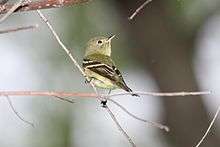Yellow-bellied flycatcher
| Yellow-bellied flycatcher | |
|---|---|
 | |
| Scientific classification | |
| Kingdom: | Animalia |
| Phylum: | Chordata |
| Class: | Aves |
| Order: | Passeriformes |
| Family: | Tyrannidae |
| Genus: | Empidonax |
| Species: | E. flaviventris |
| Binomial name | |
| Empidonax flaviventris (Baird, 1843) | |
The yellow-bellied flycatcher (Empidonax flaviventris) is a small insect-eating bird of the tyrant flycatcher family.
Adults have greenish upperparts and yellowish underparts (especially on the throat), with a dusky wash on the chest. They have a white or yellow eye ring that lacks the teardrop projection of Pacific-slope (E. difficilis) or cordilleran (E. occidentalis) flycatchers, white or yellowish wing bars that contrast strongly against the black wings, a broad, flat bill, and a relatively short tail when compared to other members of the genus. The upper mandible of the bill is dark, while the lower mandible is orange-pink.
Their breeding habitat is wet northern woods, especially spruce bogs, across Canada and the northeastern United States. They make a cup nest in sphagnum moss on or near the ground.
These birds migrate to southern Mexico and Central America.
Yellow-bellied flycatchers wait on a perch low or in the middle of a tree and fly out to catch insects in flight, sometimes hovering over foliage. They sometimes eat berries or seeds.
The yellow-bellied flycatcher's song can be transcribed as a rough, descending "TSE-berk," which can be similar to the more common least flycatcher's snappier, more evenly pitched "che-bek." To identify the difference between the two species by sound: yellow-bellied flycatchers make the sound TSE-berk at five second intervals, and the least flycatcher at one or two second intervals. [2]The three primary call notes of yellow-bellied flycatcher are a clear, ascending "chu-wee," It soua sharp, gruff "peekk", and a soft, descending "pyu."
References
- ↑ BirdLife International (2012). "Empidonax flaviventris". IUCN Red List of Threatened Species. Version 2013.2. International Union for Conservation of Nature. Retrieved 26 November 2013.
- ↑ Bates, John Christopher, Oklahoma City Community College, Cornell Online University
External links
| Wikimedia Commons has media related to Yellow-bellied Flycatcher. |
| Wikispecies has information related to: Empidonax flaviventris |
- Yellow-bellied Flycatcher Species Account - Cornell Lab of Ornithology
- Yellow-bellied Flycatcher - Empidonax flaviventris - USGS Patuxent Bird Identification InfoCenter
- Yellow-bellied Flycatcher, Environment Canada
- Yellow-bellied Flycatcher Canadian range, Canadian Biodiversity Web Site
- "Yellow-bellied Flycatcher media". Internet Bird Collection.
- Yellow-bellied Flycatcher photo gallery at VIREO (Drexel University)
- Interactive range map of Empidonax flaviventris at IUCN Red List maps
